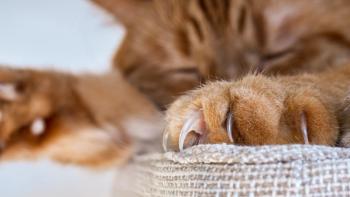
- dvm360 December 2019
- Volume 50
- Issue 12
Image quiz: Are you on the nose with this nasal issue?
When a veterinary patient presents with sneezing and obstructive nasal breathing in your practice, how are you diagnosing the patient? Take the quiz to see if you're right.
A 5-year-old, 4.5-kg female spayed Dachshund mix was presented for acute onset of sneezing and obstructive nasal breathing. Approximately three weeks prior, the dog had begun sneezing and reverse sneezing, and stertorous breathing had been noted. The dog was started on enrofloxacin with minimal improvement, and clindamycin was added a week prior to presentation with no change. No discharge or epistaxis was noted and the dog was not coughing or gagging, but snoring was now noted whenever the dog was at rest. The dog was still eating and drinking normally but would not bark, which was very unusual for this patient.
How would you diagnose this patient?
A. Rock foreign body
B. Nasopharyngeal polyp
C. Elongated soft palate
D. Unerupted permanent molar
Scroll down for the answer and official diagnosis!
The correct answer is A: Rock foreign body
Within the rostral aspect of the nasopharynx is a triangular hyperattenuating structure that measures approximately 4.7cm dorsoventral by 4.6cm mediolateral. This structure is surrounded by soft tissue attenuating material that appears poorly contrast-enhancing. The hyperattenuation and shape were highly suggestive of mineral foreign material in the nasopharynx.
This patient was small, weighing approximately 10lbs, limiting evaluation of the nasal cavity with rhinoscopy. Thus, a CT scan was elected, which allowed for clear identification and localization of the stone lodged in the nasopharynx. There was a large amount of purulent discharge and exuberant inflammatory tissue surrounding the stone, which made its dislodgement difficult, but successful removal was achieved with caudal traction using ratigator forceps and a retroflexed endoscope.
The nasal cavity and nasopharynx were then thoroughly flushed with saline, and the patient was discharged on a
Pre-endoscopytapering course of anti-inflammatory steroids. At a follow-up two weeks later,
Post-endoscopythe dog was reported to be doing very well other than minor stertorous breathing noted at night, likely a result of residual inflammatory tissue.
Nasal foreign bodies are one of several possible reasons for congestion and upper respiratory signs. The young age of this patient paired with the sudden and persistent sneezing raised a high index of suspicion for a foreign body.1,2
In a study, the mean age of presentation for nasal and nasopharyngeal foreign bodies was 5.7 years, and sneezing was present in 86% of cases, versus only 48% with epistaxis and 29% with nasal discharge.3 The lack of a response to antibiotics is likely attributable to location-often, dogs with foreign material in the nasal cavity will present with purulent nasal discharge, with the nature of the discharge improving with antibiotics as secondary infection is treated. However, signs classically return rapidly after antibiotics are discontinued because the underlying cause is still present.
As mentioned, this patient was smaller than is typical of a dog with a foreign body, as dogs weighing more than 10kg (or 22lbs) are statistically more prevalent for these cases.3 Overall, nasal foreign bodies are significantly less likely to be the cause of upper respiratory signs than nasal neoplasia, chronic rhinitis or fungal rhinitis, with studies reporting that foreign bodies make up 5 to 7% of cases.4,5 Dogs are known to inhale a variety of objects, with 81% of foreign bodies being vegetal, 14% mineral and 4.8% artificial material in one study.3 In our practice, other findings include carpet fibers, muzzle whiskers, Cuterebra and horseshoe nails.
Nasal foreign bodies should be particularly suspected in cases of acute onset of sneezing, with or without nasal discharge, and with a minimal or temporary response to antibiotics. Rhinoscopy can often identify the material, but advanced imaging may be required to localize the objects and allow for planning for best approaches for removal.
Jessica Romine, DVM, DACVIM, is a small animal internal medicine specialist at BluePearl Veterinary Partners in Southfield, Michigan. She has a special interest in interventional radiology and advanced imaging procedures.
References
1. Plickert HD, Tichy A, Hirt RA. Characteristics of canine nasal discharge related to intranasal diseases: a retrospective study of 105 cases. J Small Anim Pract 2014;55:145-152.
2. Ettinger SJ, Feldman EJ, Cote E. Sneezing and Nasal Discharge in Textbook of Veterinary Internal Medicine 2017; 8th ed: 111-115, St. Louis, MO.
3. Dias MJ, Mouro S, Leal RO. Nasal foreign bodies identified by rhinoscopy in dogs: a retrospective study of 21 cases. Presented in abstract form at British Small Animal Veterinary Congress 2018.
4. Lobetti RG. A retrospective study of chronic nasal disease in 75 dogs. J S Afr Vet Assoc 2009;80:224-228.
5. Tasker S, Knottenbelt CM, Munro EA, et al. Aetiology and diagnosis of persistent nasal disease in the dog: a retrospective study of 42 cases. J Small Anim Pract 1999; 40: 473-480.
Articles in this issue
almost 6 years ago
FDA approves longer-lasting feline preventivealmost 6 years ago
Radiography: How to use this imaging approach in acute vomiting patientsalmost 6 years ago
Speaking their languageabout 6 years ago
Just approved: Generic clomipramine for canine separation anxietyabout 6 years ago
Talk about birthing pains!about 6 years ago
Economic trends in veterinary medicineabout 6 years ago
How cannabidiol is changing the pet treat industryabout 6 years ago
AAFP releases new feline zoonosis guidelinesNewsletter
From exam room tips to practice management insights, get trusted veterinary news delivered straight to your inbox—subscribe to dvm360.





